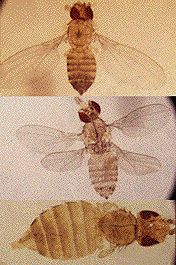Macromutations

A macromutation is a mutation of large phenotypic effect; one that produces a phenotype well outside the range of variation previously existing in the population.
Mutations with effects in early stages of development can have large phenotypic consequences. The homeotic mutations of fruitflies (Drosophila) are clear examples: homeotic mutations typically transpose part of the body from one region to another. In antennapedia legs grow out of the antennal sockets instead of antennae.
At an abstract level, it is easy to imagine how homeotic mutations work. There is presumably a set of genes encoding for the growth of a leg and another set specifying where these leg-genes are switched on. Mutations in the position-specifying genes could result in the genes encoding for leg growth being switched on in the wrong place.
Most biologists, including Richard Dawkins, doubt that macromutations are important in evolution.
The top image is of a normal Drosophila, but the other two have experienced macromutations: one has an extra pair of wings while the bottom one is wingless.
How important are these developmental macromutations in evolution?
| Next |



